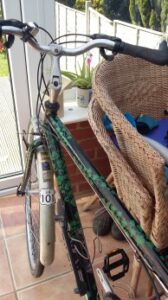Contributor: Lorraine Lambert
 Everyone needs a Covid lockdown project. Whilst I may not have been doing much cycle touring recently, I’ve definitely been gainfully employed in (many, many) other projects.
Everyone needs a Covid lockdown project. Whilst I may not have been doing much cycle touring recently, I’ve definitely been gainfully employed in (many, many) other projects.
I don’t know about anyone else but, my ‘to do’ list has never been so clear! It’s even got to the point that I write down finished jobs that weren’t even on my list just to have the satisfaction of crossing them off. One thing that had been on my list for a while was to give Claud, my touring bike, some serious love and attention, including a completely new paint job.
The idea for repainting was born sometime back from one of those random conversations at a friend’s birthday party. Chatting to an artist and fellow old-bike enthusiast, he described how easy it would be to give the bike a bespoke and quirky paint job. By the end of the chat, I had visions of full leopard print or zebra-striped frames swimming round in my head. I was going to do it; I was going to completely repaint my beloved bike.
 What I forgot to factor in, however, was that I have very little artistic talent, patience, painting materials, and until recently, time!
What I forgot to factor in, however, was that I have very little artistic talent, patience, painting materials, and until recently, time!
Undaunted, a quick trip to the local craft shop secured four small pots of enamel paint (the kind used to paint plastic models of planes) and an assortment of brushes and stencils. The local hardware store supplied primer, black metal gloss paint, and clear lacquer spray. As for having the time, when the U.K. entered lockdown mode and unable to put it off any longer, I readied myself to unleash my hitherto undiscovered inner-artist!
Day one, and it soon became apparent that before my inner artist could get to work, my outer mechanic would have to get very busy. I would say that my mechanical ability is on par with my painting, i.e., poor, but I needed a clear frame before I could do anything else, so it was time to strip Claud.
Turns out that taking things off is surprisingly easy; you just undo every nut, screw, and cable in sight. How I’ll reassemble it again is a project for another day. In fact, the only thing I can’t liberate from the frame are my front cranks which seem to have become welded to the bottom bracket. Oh well, nothing I can’t cover up with a plastic bag and tape (to be fair, this is my general approach to any D.I.Y).
With the frame stripped, lightly sanded with wire wool, and cleaned down with white spirit, I’m ready to begin. It’s actually quite daunting as I dip the brush in the primer and start gingerly applying it to the frame. Claud may be the least valuable of my bikes by far in monetary terms, having picked him up on eBay for around £60. Still, emotionally he is priceless, having carried me on solo trips across Canada and the U.S. Now here I was potentially defacing him! But primer applied; there was no turning back.
 Claud actually looked surprisingly good, many of the frame dents and scuffs had been smoothed out with his new coating, and something different was emerging. Next up was a coat of black metal gloss paint. I’d decided that the practicalities (or my limited ability) of spraying were a non-starter, so I opted for what seemed the safer option of a paintbrush. After two coats of black gloss, the frame, ignoring the odd drips and runs, was looking quite rejuvenated.
Claud actually looked surprisingly good, many of the frame dents and scuffs had been smoothed out with his new coating, and something different was emerging. Next up was a coat of black metal gloss paint. I’d decided that the practicalities (or my limited ability) of spraying were a non-starter, so I opted for what seemed the safer option of a paintbrush. After two coats of black gloss, the frame, ignoring the odd drips and runs, was looking quite rejuvenated.
In an ideal world, spraying would definitely give a neater finish, but Claud was never a neat bike, and this project was not about a pristine coat of paint. I figured, too, that the decoration would also cover any imperfections.
Frame prepared, my inner artist could finally get to work. The grand plan was to cover Claud in painted ivy leaves following the contours of the frame. Now, when faced with the large expanse of metal, with all its tubes and angles, I was immediately glad that I had bought a stencil for my design. However, working out how to fit its intricate patterns to the frame was a whole other issue.
After much experimentation (and swearing), I found that taping the stencil in a twisting corkscrew gave the best effect. Ready to go, I open up all my carefully chosen pots of enamel paint in varying shades of green, only to discover that just one of the paints actually shows up on Claud’s black frame. I am therefore limited to one colour, and with only one tiny pot (and the paint shops now closed), I need to be very sparing with it.
My first attempt using the paintbrushes fails badly as the delicate patterns smudged and blurred with the stencil’s slightest movement. On being invited to view the work in progress, my partner stared at it for a long time before pronouncing, “Hmm, looks….. splodgy. Was that what you were going for?” No, that was not the effect I was aiming for, and annoyingly he’s right—time to rethink.
Next, I try using a sponge, but this soaks up the paint without coating the bike. Then I use a rag, same thing. Finally, and lacking inspiration, I try a cotton bud (Q-tip), and amazingly this works.
It takes ages. Dabbing away at each intricate ivy leaf on the stencil, waiting for the paint to dry, then painstakingly removing the stencil and re-taping it around a different part of the frame. Just to add to the fun, every so often the stencil peels away from the frame whilst I’m painting and pings messily across the room. Aargh!
Slowly, however, the ivy pattern emerges and starts to cover Claud, and surprisingly…..it looks ok! I even sand down and repaint the original splodgy bits using fresh black paint and my new stencil technique. It takes time, but then I have a lot of that right now.
Finally, around two weeks after starting, the frame is complete. Swathes of ivy adorn everything from top tube to rear forks. The last finishing touch is to add Claud’s name in discreet silver lettering near the steerer tube and spray over a clear, protective lacquer layer.
I’d be more than happy to finish now with a satisfied sigh, but if Claud is ever to show off his new paint job in public, I need to put everything back on that I took off, basically the whole drive chain, brakes, and shifters.
 To say it’s a grim labour would be an understatement. Still, there’s also a measure of pride in there when me (and YouTube) finally work out how to re-thread brake and gear gables, how to mount front and rear derailleurs, fit and adjust new brake blocks, and generally turn a painted lump of aluminum back into a functional bike. Additionally, anything I can do to improve my bike fixing skills has to be a bonus for future cycle touring.
To say it’s a grim labour would be an understatement. Still, there’s also a measure of pride in there when me (and YouTube) finally work out how to re-thread brake and gear gables, how to mount front and rear derailleurs, fit and adjust new brake blocks, and generally turn a painted lump of aluminum back into a functional bike. Additionally, anything I can do to improve my bike fixing skills has to be a bonus for future cycle touring.
After some initial deliberation, I’d decided to retain (and not paint) Claud’s original mudguards, covered as they were in the provincial flag stickers of Canada and highway 101 from my cycle tour a few years ago. The final thing I do is re-install those mudguards, and I’m glad I kept them. They make the bike what it is, an amalgam of old and new, my history, and the promise of other adventures to come. As for future travels, we do have plans, Claud and I; we’ll just have to wait a little longer, I think.
Total cost of the project, approximately £15 for paint and materials. Priceless!






